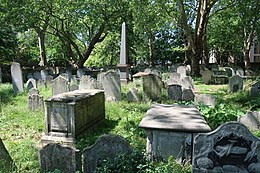Our website is made possible by displaying online advertisements to our visitors.
Please consider supporting us by disabling your ad blocker.
Bunhill Fields
| Bunhill Fields Burial Ground | |
|---|---|
 Monuments in Bunhill Fields | |
 | |
| Details | |
| Established | 1665 |
| Location | |
| Country | England |
| Coordinates | 51°31′25″N 0°05′20″W / 51.52361°N 0.08889°W |
| Type | Public (closed) |
| Style | Frequently Nonconformist, many social classes represented |
| Owned by | City of London Corporation |
| Size | 1.6 hectares (4.0 acres) |
| No. of graves | 120,000 |
| Website | Official website |
Listed Building – Grade I | |
| Official name | Bunhill Fields Burial Ground |
| Designated | 5 May 2010 |
| Reference no. | 1001713 |
| Official name | Bunhill Fields Burial Ground |
| Designated | 5 May 2010 |
| Reference no. | 1001713 |
Bunhill Fields is a former burial ground in central London, in the London Borough of Islington, just north of the City of London. What remains is about 1.6 hectares (4.0 acres) in extent[1] and the bulk of the site is a public garden maintained by the City of London Corporation.
It was first in devoted use as a burial ground from 1665 until 1854, in which period approximately 123,000 interments were estimated to have taken place.[2] Over 2,000 monuments remain, for the most part in concentrated blocks. It was a prototype of land-use protected, nondenominational grounds, and was particularly favoured by nonconformists who passed their final years in the region. It contains the graves of many notable people, including John Bunyan (died 1688), author of The Pilgrim's Progress; Daniel Defoe (died 1731), author of Robinson Crusoe; William Blake (died 1827), artist, poet, and mystic; Susanna Wesley (died 1742), known as the "Mother of Methodism" through her education of sons John and Charles; Thomas Bayes (died 1761), statistician and philosopher; Isaac Watts (died 1748), the "Father of English Hymnody"; and Thomas Newcomen (died 1729), steam engine pioneer.
Bunhill Fields Burial Ground is listed Grade I on the Register of Historic Parks and Gardens.[2] It is now maintained by the Friends of the City Gardens.
Nearby, on the west side of Bunhill Row and behind the residential tower Braithwaite House, is a former Quaker burial ground, in use from 1661 to 1855, at times also known as Bunhill Fields. George Fox (died 1691), one of the founders of the movement, is among those buried there. Its remains are also a public garden, Quaker Gardens, managed by the London Borough of Islington.
- ^ Cite error: The named reference
CityOfLondonwas invoked but never defined (see the help page). - ^ a b Historic England. "Bunhill Fields Burial Ground (1001713)". National Heritage List for England. Retrieved 15 May 2020.
Previous Page Next Page


